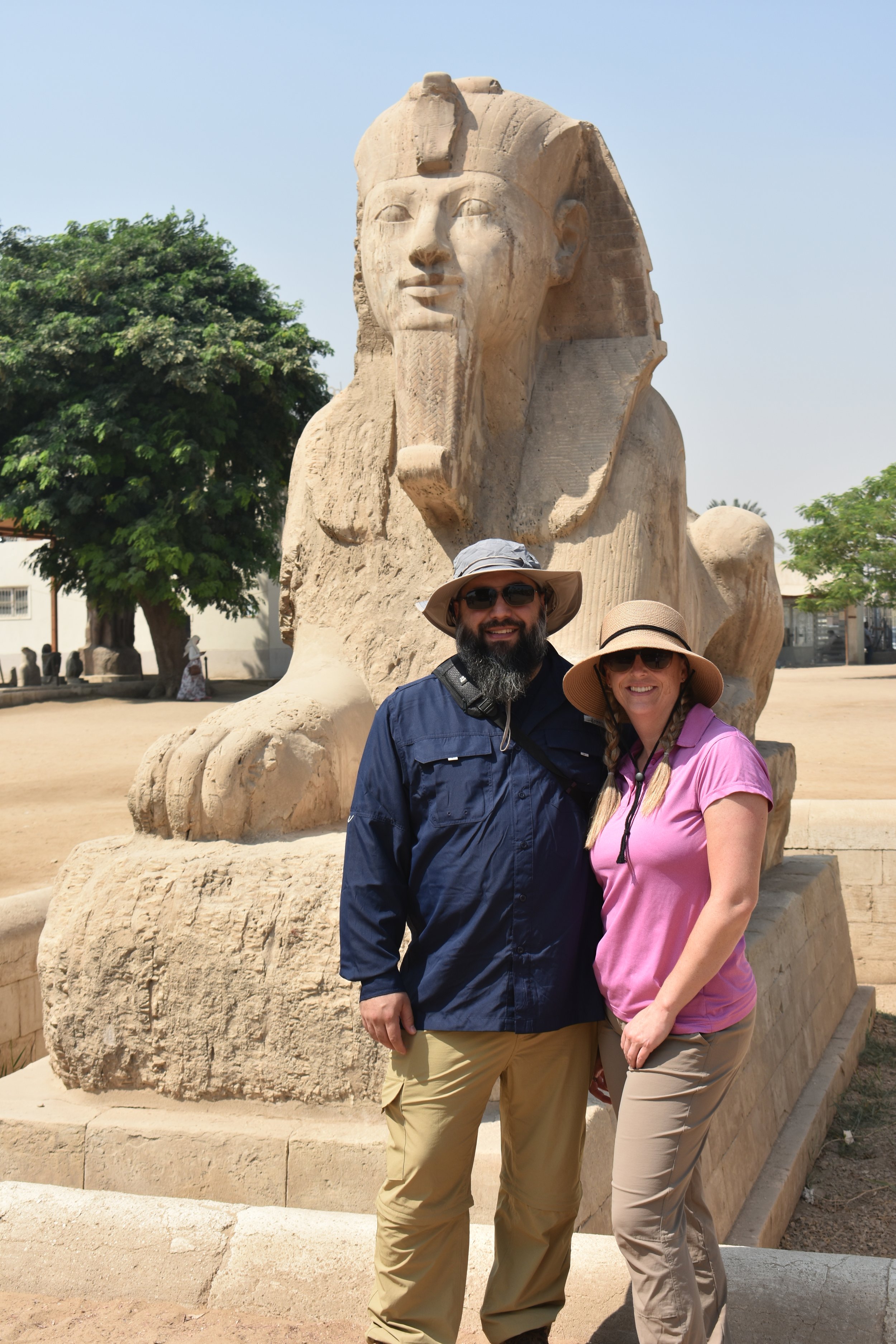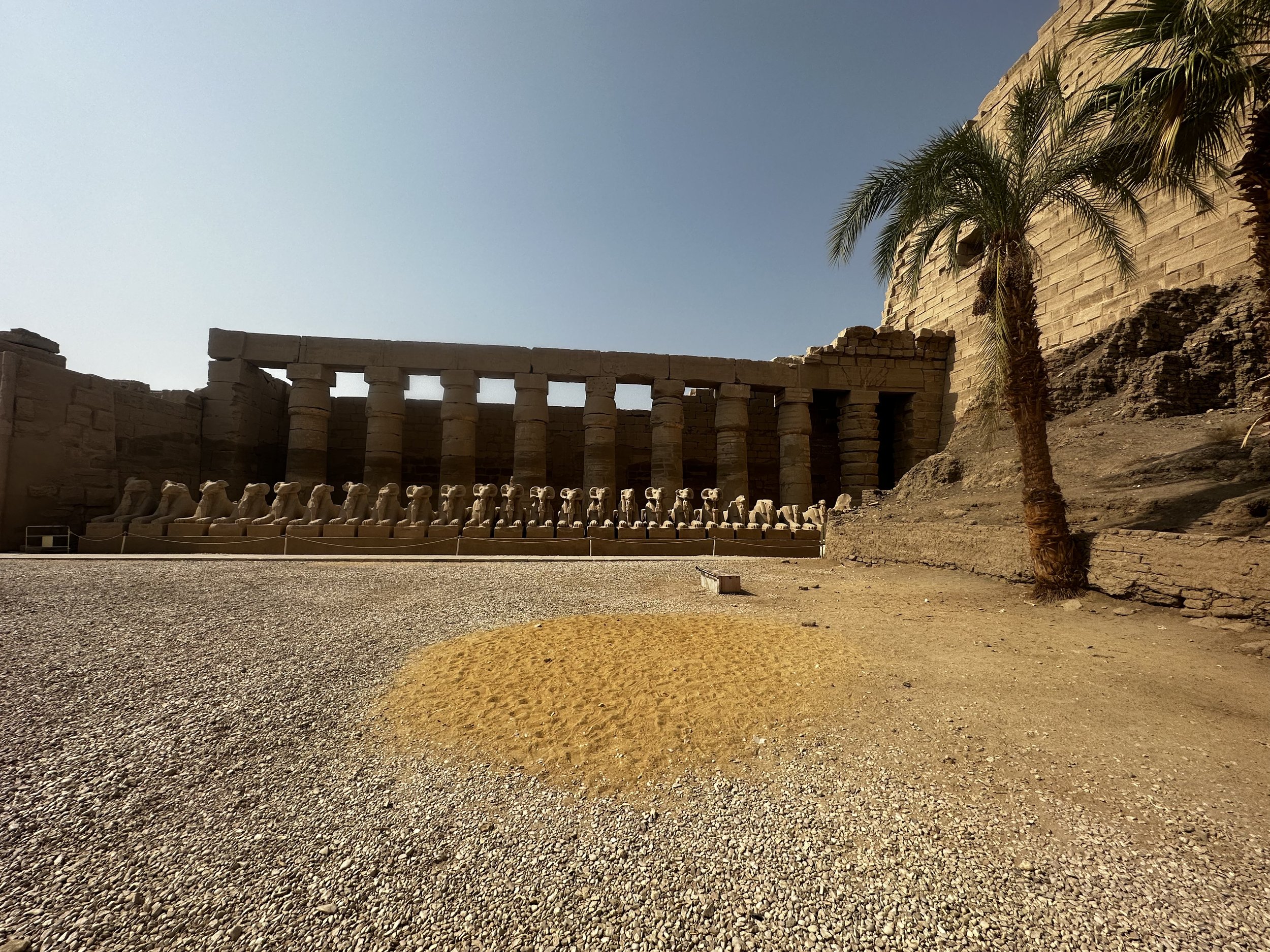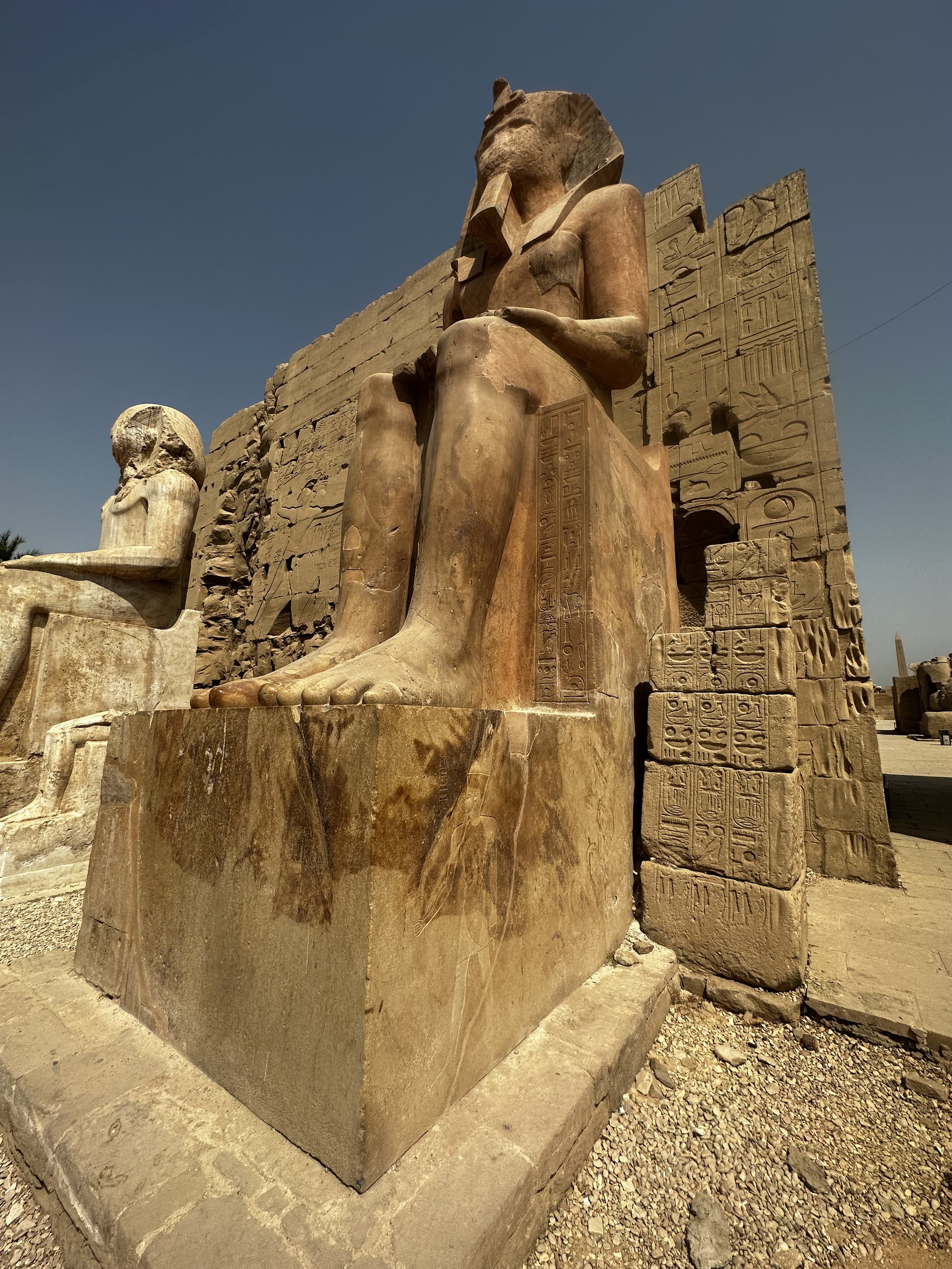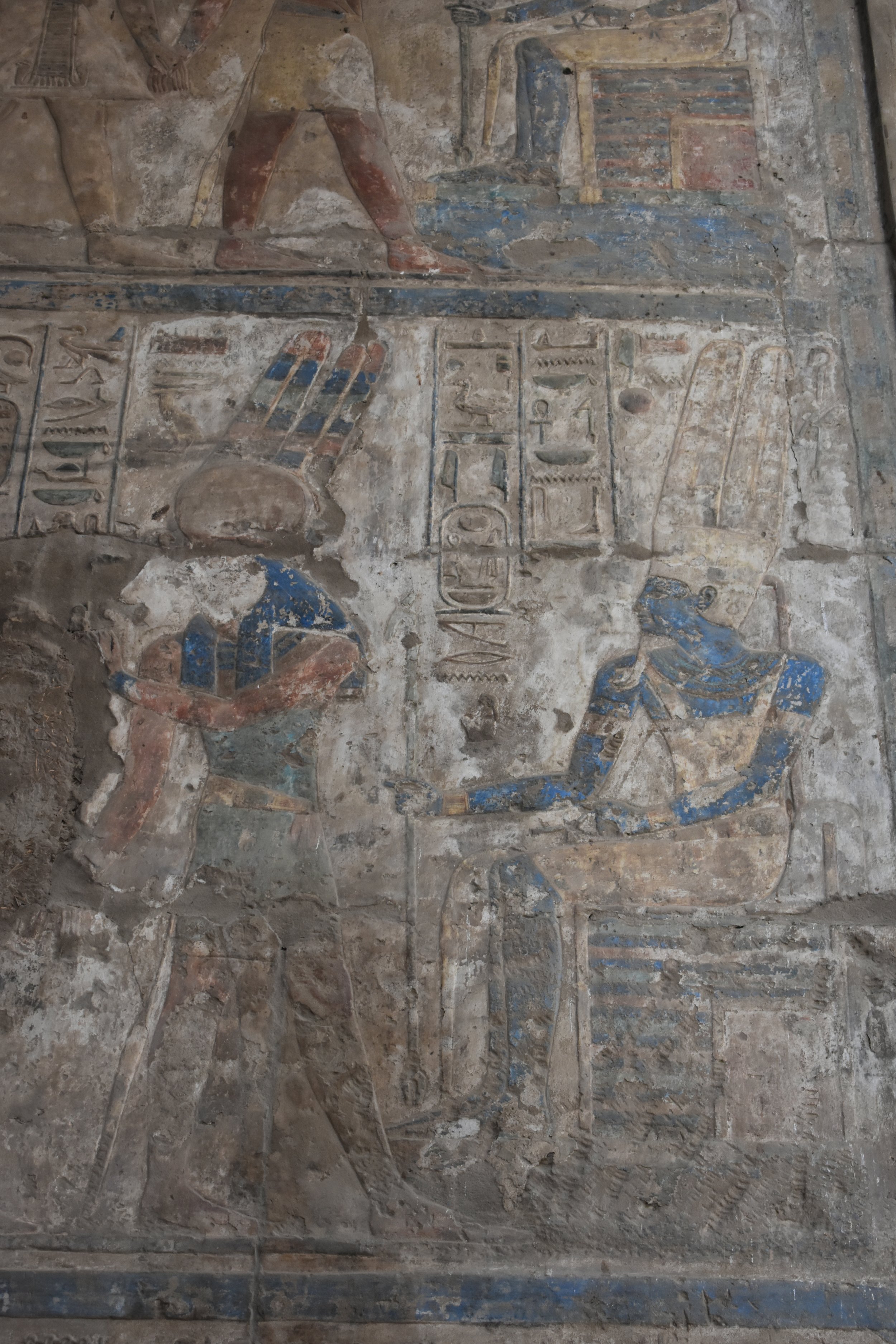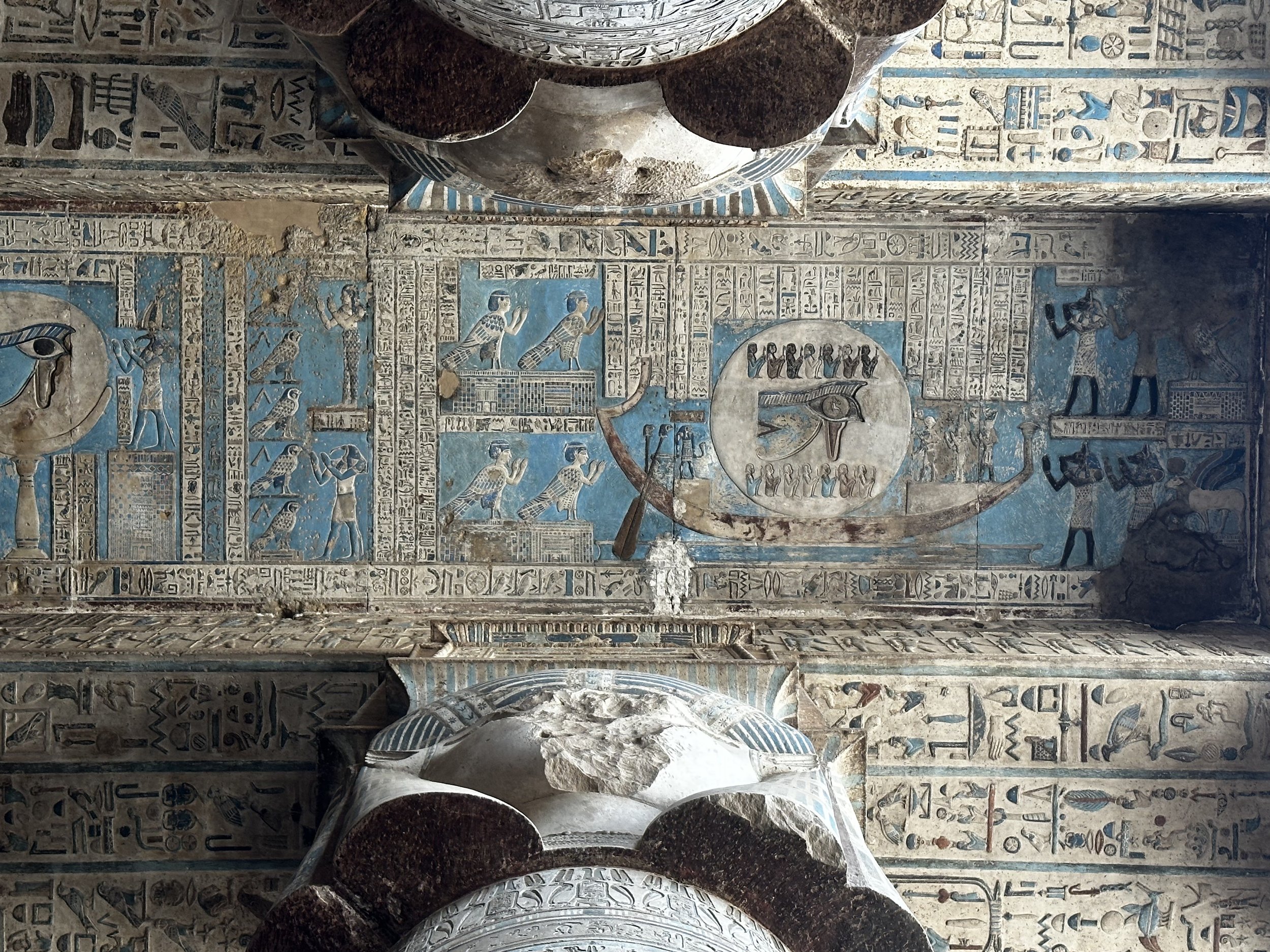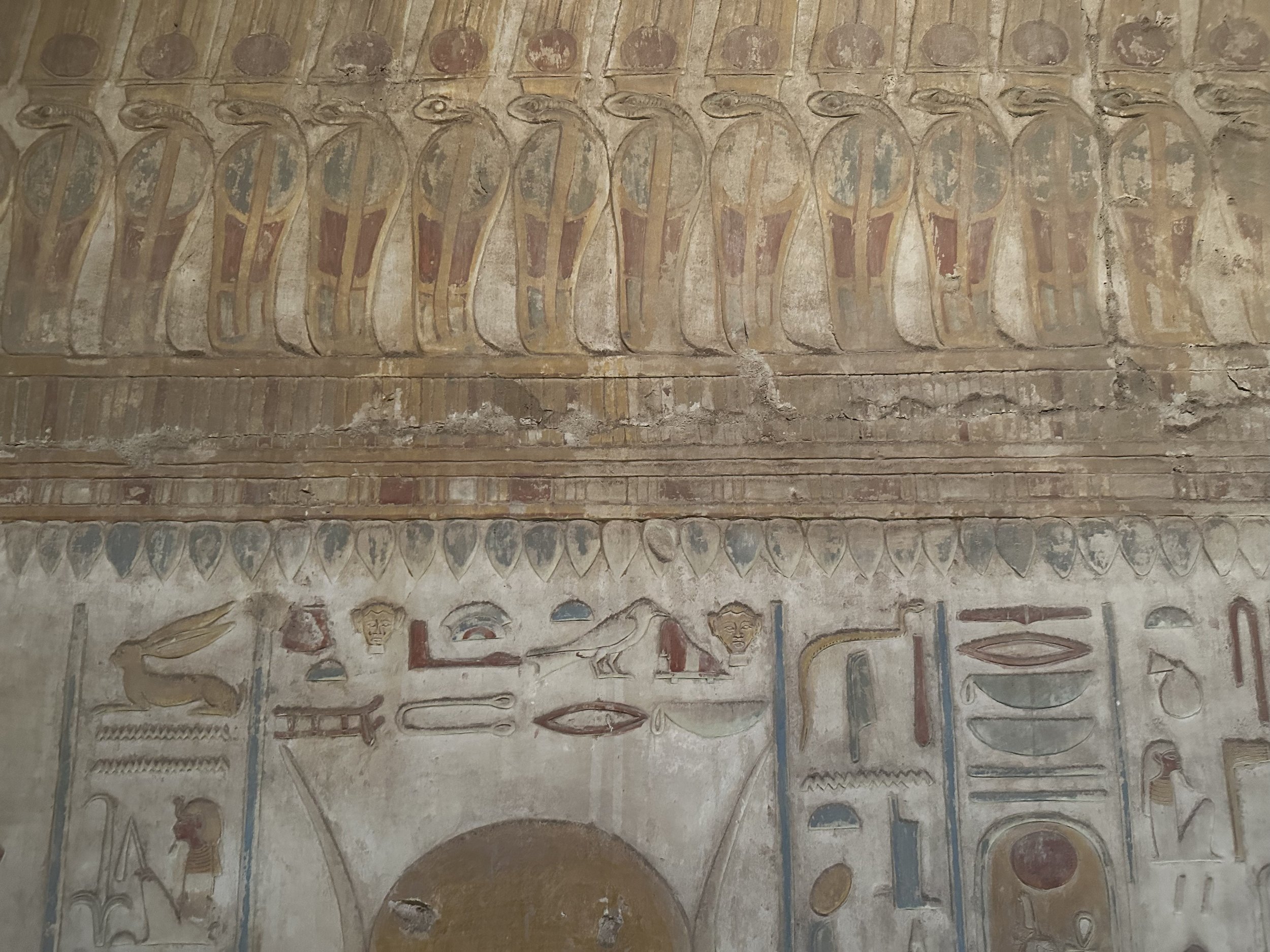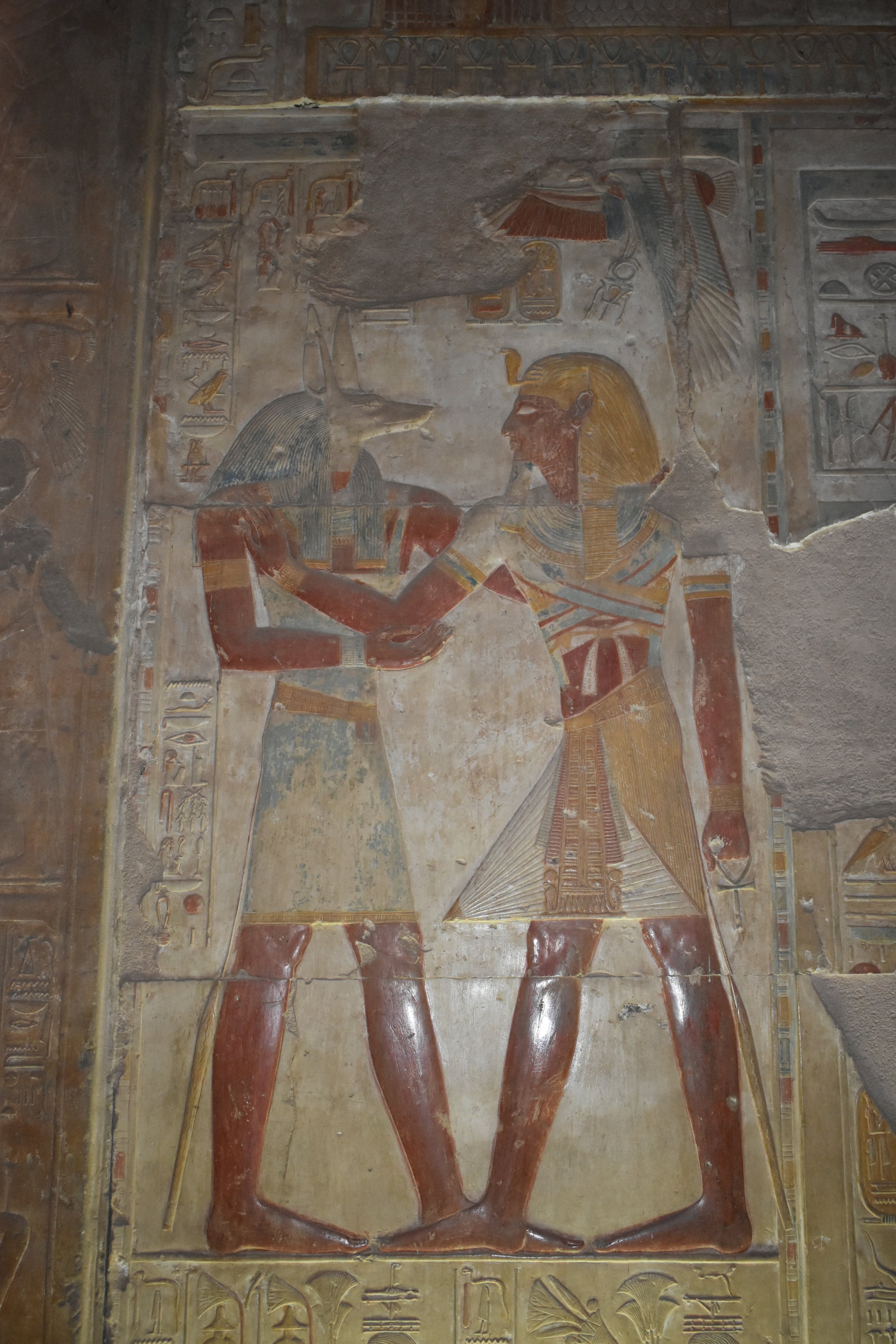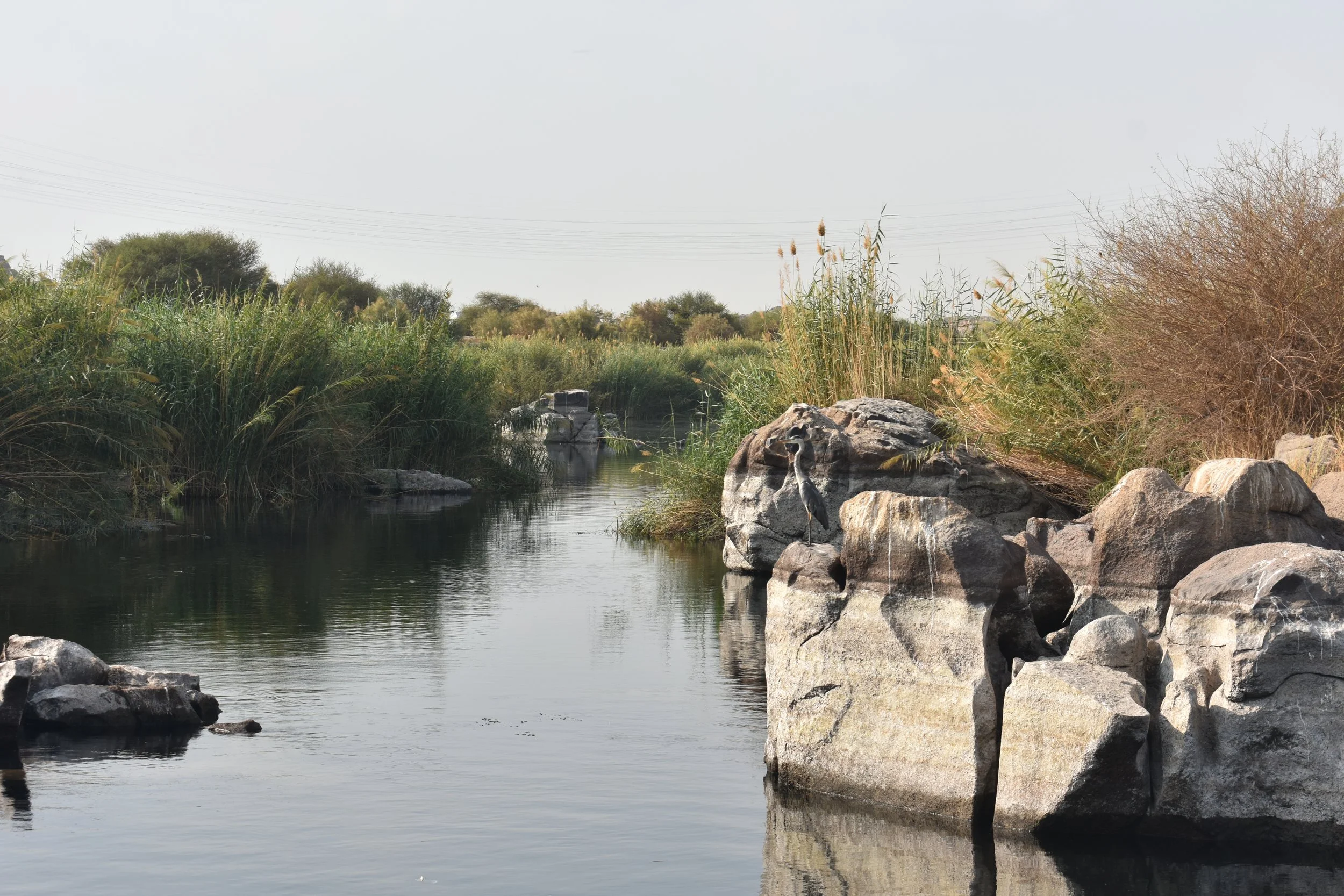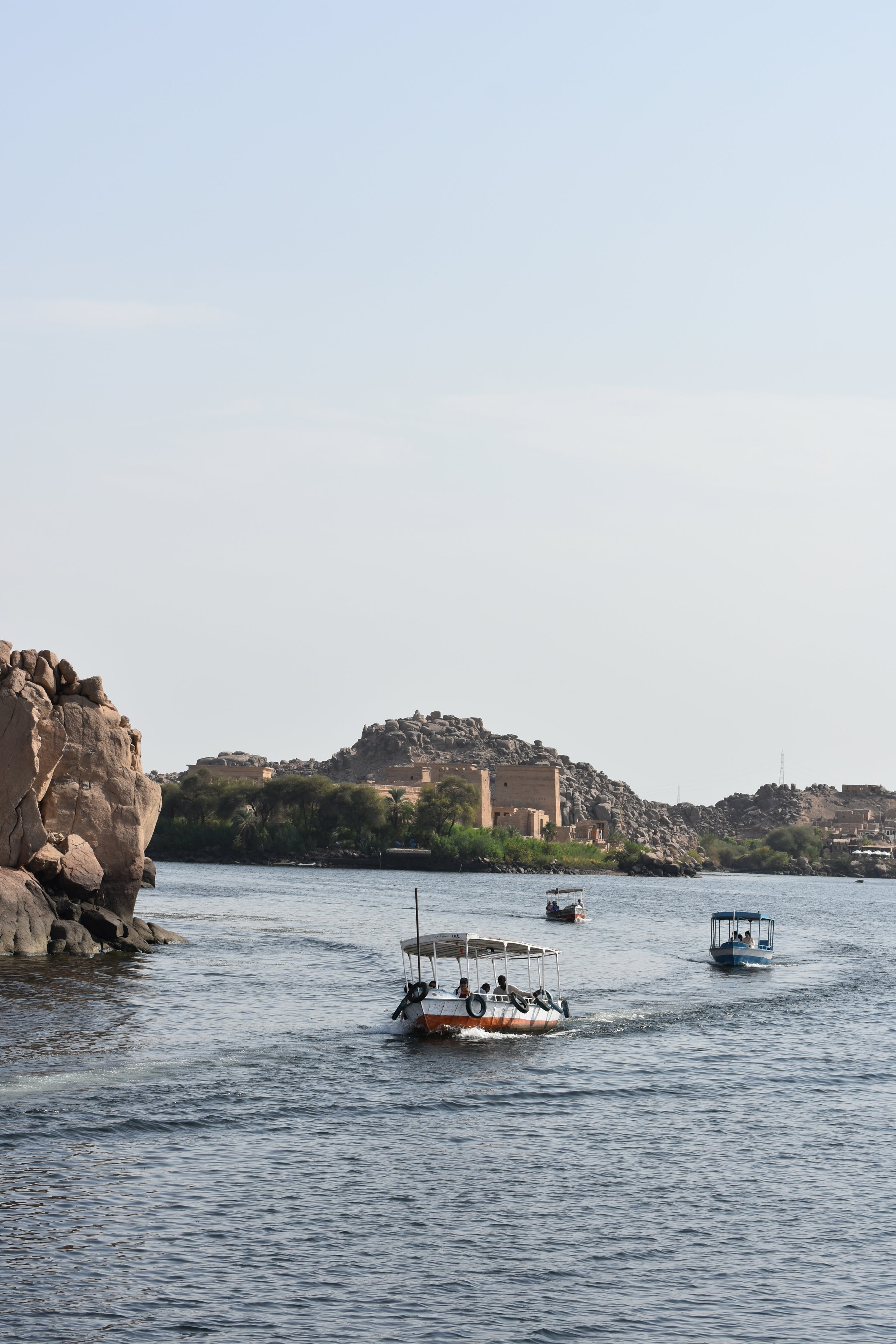Egypt 2023
In the fall of 2023 we traveled to another of the early cradles of western civilization, the Nile valley of Egypt. Egyptian history spans thousands of years with ancient pyramids, temples, and tombs all situated around the Nile river. We also found modern marvels like the Aswan Dam, the Cairo/Giza metropolitan area, and the many museums that house the treasures of the ancient world.
The How and Why
Getting to Egypt from the Midwest is a bear and a half, typically it would be a commuter flight to a hub, and then another flight across the Atlantic, and then another flight to Cairo. This year we got to take advantage of a St. Louis to Frankfurt non-stop on Lufthansa Airlines flight, and then a four-hour flight to Cairo. It might not seem like much, but it was one less thing to worry about with the unreliability of flights these days. We also used a local travel agency in Egypt, Memphis Tours, and we can’t say enough about how amazing it was. If you’re interested in how we did it, we wrote it all up here.
Egypt is in a troubled part of the world, highlighted by two terrible events that happened in the days after we left. We really wanted to get this trip in and luckily we picked the perfect time to go. September into October was advertised as the perfect time to visit, not too crowded, not too hot, and long away from the dust cloud season. It was in fact hot while we were there with highs in the 110s and lows in the 80s.
Giza
After a long day of flights, we landed in Cairo and were met by our tour leader. We were driven to our hotel to relax for the rest of the day, get a little pool time in, and enjoy dinner at the hotel restaurant. The next morning we were up early and on our way to the pyramids. A consistent theme through our trip was getting up early to beat the crowds and the heat. We were met in the hotel lobby by our tour guide, Ahmed, and our driver, Anwar. Even though we could see the pyramids from our hotel, we had to take a roundabout way of getting there because one-way streets seem to be the norm in town. Unlike many sites, the pyramids are every bit as big as we’d imagine they’d be. We grabbed a few photos in front, and then climbed up the first few steps for a few more. There is an option to go in, but it would have been crawling on our hands and knees to get to an empty room and our guide was going to take us to another one that wasn’t as bad. We travelled around to the back and got on our camels to get a more unique view. From the backside there were very few people in the way of our pictures. The camels were… interesting, they’ve certainly got a little bit of an attitude, but our guide was pretty good and helped keep them walking in the right direction without getting too irritated that we were on their backs. Once we’d finished our ride, we swung by the Sphinx, this was a little smaller than we thought it would be, so we got our pictures and hit the road.
Memphis
Our second stop of the day was Memphis, the original capital of Lower Egypt. It was about an hour drive where we passed everything from semi-trucks to donkey pulled carts. Driving in Egypt was a show all by itself with pedestrians crossing whenever and wherever they want mixed in with carts, motorcycles, cars, and trucks. Each of them was doing just enough not to hit anyone or anything while not give up an inch in the race to the next turn.
When we arrived in Memphis, we toured a site with a number of outdoor Ramses II statues and carved wall pieces. There was also a covered area housing what remained of a colossal Ramesses statue that was discovered face down in the canal.
Sakkara
Our last stop before lunch was the temple and pyramid in Sakkara. The temple is the Funerary complex outside the Pyramid of Djoser. We were able to actually go down into this pyramid but the lights went out on us just as we got to chamber housing the sarcophagus at the bottom of a deep chamber. Apparently this is a somewhat common occurrence during the summer. Back in Cairo, our guide took us to a couple of shops, we saw some nice jewelry and got a nice sport coat. The only bad thing about the coat was that it now needed to travel with us for the entire rest of the trip. We spent a little time in the afternoon back at the hotel to enjoy the pool and get cleaned up for our night on the town.
Our driver picked us up and took us to downtown Cairo where we met our tour leader. Our first activity was a boat ride on the Nile. There are hundreds of excursion boats of all sizes plowing up and down the river. Ours looked like it could have held 50 people and we had it all by ourselves. As exotic as a ride on the Nile sounds, it could have been better. The Egyptians living in Cairo and Giza don’t really take care of the river, it’s lined with trash and it’s very sad to see the ducks and fish having to work their way around it all. Once we got out towards the middle of the river, the view was a little nicer. The Cairo/Giza area has a population of 20 million people, the roads are crowded, the sidewalks are crowded, and even the buildings look like they are overflowing with residents, but somehow the river was slow and peaceful. After our ride we went to dinner at the locally famous Abou Tarek, a restaurant renowned for its cheap but delicous eats. The owner of the chain, Youssef Zaki, has a famous thoughtful look that is often imitated.
Our dinner was the house special, Koshary, a pasta dish of rice, pasta, lentils, onions, chickpeas, and spicy tomato sauce. You can order it pre-mixed or have everything come out and mix it yourself. It was pretty good for dish with no meat in it. We tried a couple of the desserts and then took off for a coffee shop. Sitting outside the shop and drinking coffee well into the evening is how a lot of Egyptians end their day. It’s even more fun if there’s a soccer match on, bonus if it’s against a neighboring team.
Alexandria
A six hour round trip drive, but it was an interesting drive for sure. We were first stopped by a fog advisory that turned the road into a social hour by the nearest coffee stand. Once the fog lifted, it turned into a mad dash to get back to vehicles before being left behind. The highways are very smooth with plenty to take in along the way. The most intriguing thing might have been the large number of pigeon houses, pigeon is a common dish among Egyptian families. Once we arrived in Alexandria, the driving situation that we had become accustomed to returned and it was every vehicle for itself. Our first stop was the Kom El-Shouqafa catacombs. This deep resting place of rich and poor alike was built around a well-like opening used for lowering the bodies. Rich people were buried closer to the top in ornate cubbies with a carved sarcophagus. Towards the bottom there was row after row of tombs dug into the rock with simple lids on them. In the same area, there is also the Tigrane Tomb built for some long forgotten rich guy.
Our second stop was Pompey’s Pillar, all that remains of a temple that once stood here. The pillar was built to honor the Roman Emperor at the time who had pity on the city and spared them taxes during a drought. The site itself is open air with a walking path around the back that leads up to the pillar itself. It only takes about 10 minutes to walk the entirety of the site. Unfortunately this was also the site that two tourist and their guide were killed just a few days after we got home.
Pompey’s Pillar
Our last stop before lunch was the Library of Alexandria, built to look like the wall of a pyramid with the interior supports made to look the same way. The library doesn’t have anything about the ancient library that burned down during antiquity, but the walls are adorned with cubbies to mimic how scrolls were stored back then. After lunch we visited our final site, the Qaitbay Citadel, built by the Arabs from the remains of the Lighthouse of Alexandria. The Citadel holds an imposing position guarding the entrance to the old harbor, although the commercial port has now moved several miles down the shore. The Citadel is three very tall levels with thick walls and the remains of large caliber gun emplacements. It’s full of interesting views of the city, harbor, and ocean through its turret windows, archer slits, and commanders balcony.
Jessi’s Farm and the sleeper car
Our third full day in Cairo was a welcome respite from the busy schedule we’d had so far. We spent the day out on the family farm of our tour guide. This is a trip offered as a half day trip by Memphis tours, but they were kind enough to let us hang out all day while we waited for our train. We enjoyed breakfast made up of Feteer, an Egyptian pastry with molasses and honey to dip it in. After breakfast we toured the farm, Miranda went on a donkey ride, and then we played games while waiting for lunch. Miranda played Uno with our guide’s little girls and then taught them and a neighbor how to play checkers. Pogue was suckered into play dominos with our driver for the day, the score got to be so bad that he started laying his dominoes on the table face up. We got to see them make bread and then enjoyed lunch of that bread, duck, potatoes, rice, and rice wraps. Before heading to the train, we got to go next door and watch the neighbors harvest peanuts. Many of the folks working on these farms have day jobs and then go out in the evening to tend their fields.
A hairy car ride later that included roads closed because of a fire, driving the wrong way, and then stopping to ask for directions from one of the street vendors, we were on the platform waiting for our train. The next hour and a half saw us approached by tourism police five times to inspect our tickets and make sure we weren’t missing our train. Luckily our tour leader, Monica, was with us the whole time and helped us navigate the experience. There were no English announcements or signs, so we would have been up a creek without her.
The sleeper train was a new experience for both of us. By the time we boarded the train, it was already 9:30, so we weren’t getting any cool countryside views. Our cabin attendant helped us navigate the room since the footrest doubles as a latter, the bottom bunk doubles as chairs, and we had trays that attached to the walls for meals. The dinner wasn’t half bad and we had a nice little spot to put up our iPad and watch a show while we ate. The bathrooms were a whole other matter. There is a sign on the door that says the bathrooms cannot be used while the train is at the station, that’s because the toilet is just a trap door that opens on to the tracks. Not going to lie, that was a pretty disgusting discovery. The mattresses weren’t great, the tracks were pretty rough, and noises were pretty loud, so we knew we were in for a bit of a long night. On the bright side, the air conditioning worked well so we just decided we’d need to take something to sleep better next time. The next morning they served breakfast about an hour before we were set to arrive at the station and then off we went. We had one more train trip ahead of us but this would certainly be the last time we do sleeper trains without a little more research.
Luxor
After getting off the train we were immediately greeted by people trying to help us with our bags, for a tip. We got outside and didn’t see our guide so we got to experience the cabbie badgering for the first time in Egypt. One after another would come up to us, ask us where we are from, what hotel we are staying at, and offering us a ride if our guide didn’t show up. After nearly an hour, and multiple calls and messages, our guide showed up. Trains are notoriously unreliable, so often times guides will try to ask the train conductor for their phone numbers to pass it along to the next guide to get updates. Our guide in Luxor was told we’d be arriving an hour later than we did, the train connections were really the only issues we encountered on the trip.
Because of our late arrival, we needed to switch our itinerary up, so we went straight to the temple of Karnak. The temple and museum are mostly open air and it’s massive. We would have just been looking at statues and carvings if not for our guide. There are no descriptions or placards around the area, so we wouldn’t have gotten much if we were just wandering.
Our second stop was the temple of Luxor which was a much smaller site, but just as well preserved. There are pictures from the early 1900s that have some of the temple visible and the heads of the statues peaking out from the sand. The temple had multiple Ramses statues outside with a temple built by Alexander the Great inside. There was also a massive row of sphinxes known as the Avenue of Sphinxes.
We were taken to our hotel, the Sonesta Luxor, where we enjoyed some time at the pool. We ordered room service and called it a night. We had a very early start time and a fun packed day ahead of us.
Valley of the kings Balloon Ride
The next morning we were picked up from our hotel at 4:25. It was too early for the hotel breakfast, so we got our box breakfast of pastries and fruit to go. We took a van ride to the dock and boarded small boats for the journey across the Nile. There was a small fleet of vans waiting for us on the other side and then we waited for our police escort to the balloons. There was literally no reason for the Mario-carting on this small road with everyone going to the same place, but the drivers couldn’t help themselves.
We arrived to an open field with a bunch of trucks but didn’t see balloons. Then seemingly all at once, generators started cranking and groups of men pulled the balloons out of their baskets that had been tipped away from us. Once the blowers filled the balloons about halfway, the large burners started firing and the balloons took shape. It was a pretty amazing site to see two dozen balloons begin to rise and lines form to jump in. We were lined up in groups of four and then asked to climb over the basket walls into large stalls. Each basket could hold 32 passengers. Our pilot was Captain Bob and he was obviously the most adventurous of the group. Our balloon traveled further than any other and he regularly skimmed the tops of buildings and trees to get us some up close and personal shots. The wind wasn’t taking us towards the temple of Queen Hatshepsut and the valley of the kings, but we still got some good shots from above. The ride took us over the town of At Tarif and we got to see people starting their days and a few still sleeping on their roof patios.
After landing, we got back in our bus that had been following our balloon. The bus took us back across the river to check out of our hotel and head to the temples of Dendara and Abydos, which saw us on the road for six of the next ten hours.
Dendara and Abydos
We knew there was going to be some driving ahead of us, but it was worth it to see these two temples. People don’t always make the trek out here, so we knew it wouldn’t be very crowded. There is a main highway that follows the Nile, but in this case, we were done in by the large bend in the river that made the distance double what it would have been walking straight through the desert.
The first temple we visited was Dendara, dedicated to the goddess Hathor. The temple is still in amazing shape and many of the ceiling and wall carvings still have their original colors although a great deal of restoration has recently been completed. We first toured the outside to see the lion’s head roof spouts and intricate carvings on the outside. Next up was the inside and right away we were greeted by giant columns and the face of Hathor at the top of every one of them. The ceilings are very high, providing plenty of space to tell stories on the walls and columns. The ceilings themselves are incredible with their bright blue colors.
After we had lunch at the very swanky looking House of Life Abydos Hotel, we moved on to the Temple of Seti I in Abydos. This temple was built to honor the Egyptian god Osiris and is the last remaining temple in what is believed to have been as many as ten temples in the area. It was still in amazing shape. There’s a long walkup with stairs that gives you a feel of it being larger, compared to some of the other temples. It had a lower ceiling, but that just made it easier to see the remarkable carvings above. There were multiple chambers inside and a recent discovery even found that the world’s oldest brewery might have existed on this site. We toured the chambers, got a great possessed picture of Miranda, and then ran across a group of women that were there to take in the power of the site. Apparently they make the pilgrimage there every so often and some of the early ones involved them running around naked. Now the guards follow them around pretty closely to prevent a repeat. On our way to one of the back chambers, we were advised to wait in the hall while another meeting of some kind was finishing. This group was apparently praying and the guides believed that being in the room while they did that would bring misfortune. The final thing to see before we wandered the temple getting pictures was the Osireion, which is still being excavated behind the temple. There were still pools of water in the bottom and, for now, the whole site just resembles an underground catacomb being dug up.
Jaz jubilee
We boarded our home for the next four nights. We were weary from a long day and were hoping just to kick back and relax. We knew from some research that we did that this wasn’t going to be a super luxurious boat but we were initially a little surprised at the look of the Jaz Jubilee from the dock. As time went on, we noticed that the power plants on these boats aren’t the cleanest burning, and many of them look a bit rundown for it. Once we got into our room we were immediately greeted by a bathroom that wasn’t as clean as it should have been and we went into clean mode, wiping down every hard surface and avoiding the soft surfaces until we could check for bugs.
The Jaz Jubilee only has 80 cabins, the dining room is fairly small and takes up almost the entire first deck. A bar and lounge takes up about half of the fourth deck, and then the entire top deck is open air with a sun shaded bar and small pool. The drinks were reasonably priced, although the package we got didn’t include bottled water, not the end of the world, but it seemed like a weird thing to skimp on. The food was good but somehow the breakfast ended up being a letdown, that feels like blasphemy on a cruise, but outside of pastries, this seemed to be the norm in Egypt.
On a few occasions, we got the chance to just hangout while the Jaz Jubilee made her way down the river. Unlike in Cairo, the Nile was beautiful the further south we got. We passed large and small towns, other cruise boats, and even small boats of two or three people that would latch on and attempt to sell stuff before giving up and moving on to the next boat. The plumes of smoke from the diesel engines took something away from the experience; but overall, it was good until we got too warm and went back inside. We also got some great pictures at night with the lower light pollution.
Valley of the Kings
Today we were joined by another group from our boat and we travelled to the Valley of the Kings for an amazing day of visiting the final resting places for some of Egypt’s most famous rulers. We did a quick tour of the visitors center to get a better idea of our choices for the next couple of hours and then jumped on a golf cart to be taken up the hill. The valley itself is very non-descript, no elaborate temples or markings of any kind that would let us know we were standing on a literal treasure vault. Tomb robbers still found them and they cleaned out most of the tombs with the exception of Tutankhamun, the boy king who died when he was eighteen. The lack of time for preparation for his tomb made it harder to find, and in the end, ensured that all of his belongings would be kept safe. Picking a tomb to go into can be daunting, we had the pass that allowed for access to three of a long list of tombs, as well as two dedicated passes for Tutankhamun and the joint tomb of Ramses V & VI. We relied on Ahmed to guide us in the right direction and then we just let the line length decide where to start.
Ramses III was our first tomb, the line was a little shorter so we took advantage. This one was a good tomb to start in because it wasn’t very large. Rameses III was murdered by conspirators in his own court, recent testing found that his throat was slit. The tomb can only be partially explored but the areas we visited were decorated with very ornate carvings on the walls and ceiling.
Ramses IV was our next tomb. This tomb was much brighter that Rameses III and consisted of a long tunnel with a massive stone sarcophagus at the end. The rest of the tomb was blocked off, so we couldn’t see the last section, but the maps indicate that there wasn’t much back there.
Ramses V & VI shared the same tomb. The path down to the sarcophagus chamber was long with a large open chamber at the end that once housed both pharaohs. The walls were the best decorated of all of the tombs we saw in the valley.
The tomb of Merenptah is the second largest in the valley. At the end of the long corridor is the sarcophagus with its lid next to it. Originally he was buried nested inside four sarcophaguses, but the outer one is all that remains in the tomb.
Tutankhamun, the boy king, died at an early age and the size of his tomb reflects that. Discovered in 1922, this tomb was the only one not plundered and yielded an amazing trove of treasures that we would see later in the museums. The tomb itself was very crowded, there were signs saying that only a certain amount of people would be allowed in at a time but that wasn’t followed. The only things to see were the decorated walls of the burial chamber which show the famous twelve baboons. The baboons represented the twelve hours of night passing into the afterlife. The sarcophagus platform was in the middle of the chamber while Tutankhamun remains were in a climate-controlled glass case off to the side.
A short drive away from the valley is the temple of Queen Hatshepsut. She had quite the history, and her likeness is often defaced, but there are still many untouched statues and carvings in her temple. We were able to see this temple easily from the balloon ride earlier. It’s carved into a cliffside with a long walk up that allows for some great pictures.
On our drive back, we made a stop at Imhotep Alabaster stone masonry shop near Luxor. Here we found our big souvenir for the trip, a red granite statue of Bes. Bes is the Egyptian god of a good time among other things. We’d been seeing statues and carvings of him for a few days now and decided that everyone comes home with something like a pyramid or burial mask, we were going to bring Bes home!
Edfu
After a night on the river, we arrived in Edfu, home of the Temple of Horus. We were greeted at the dock by our ride for the day, a horse drawn carriage. There are ALOT of these in town and they seem to be the accepted mode of transport from the dock to the temple. There’s even a large stable area for them near the parking lot. The Temple of Horus is the second largest temple in Egypt and is just as impressive on the outside as it is on the inside. The massive carvings outside have seen a little wear over the centuries but are still awe-inspiring.
Kom Ombo
Back on the boat for lunch, our ship continued its trip down the river towards Aswan with a stop in Kom Ombo. Here we would tour the temple of Sobek and Haeroris overlooking the Nile.
The last part of this stop was the small museum that contained dozens of mummified crocodiles. They were a little hard to get good pictures of from behind the glass but between the air conditioning and tasteful posing of the animals, this ended up being a really fun little spot.
Aswan
The next morning we docked in Aswan, we would be here for the next two days. We had a morning excursion to the Nubian Village, I might not sound super enthusiastic about this stop in my description. It was fine, but we were led to believe it was a little more of a representation of how folks used to live along the river rather than just a village that’s a bit cut off from the main roads. Hands down our favorite part was the boat ride. This was like several of the other boats we’d been on, but there were some seats on the roof that we spent most of the time in. The Nile river between the lower dam and Aswan has a number of small islands with several types of birds, including cranes. The islands create small fast moving channels between them and the boat pilot made things a little more interesting than he probably needed to.
The village was just a small tourist trap with shops up and down the street. We stayed at one small house and had a drink while our guide told us a little bit about the history of Nubians. We did get to see some baby crocodiles and Miranda held one of them. Spice shops seemed to be all over the place there, and we did bring some tea home with us. We rode the boat back to the Jaz Jubilee for lunch, but along the way we also saw the Elephantine Island with its elephant looking rocks. If you used your imagination then you could see what they meant.
Our afternoon was going to have an old and a new wonder in the form of the Aswan High Dam and the Temple of Philae. Our party of five had now become 11 as we were joined by our replacements, the folks who would be taking the Jaz Jubilee back north to Luxor and were staying at one of the local hotels. Our first stop was described as the Granite Quarries where so much of the building material came from for the surrounding temples, there was even an unfinished obelisk. I’m not sure what we expected, but it was just a small open area off the road with rocks, so we moved on to the dam.
The bus ride up to the High Dam included driving over the lower dam. The High Dam was built in the 1960’s with money and know-how from the former Soviet Union. There is a giant monument on the west side of the dam commemorating the effort. It’s not a very pretty damn, not like others where there’s usually a good place to get a picture of it, but I guess it serves the purpose of the millions of people it provides electricity to, even if that means I didn’t get a good picture of it. Best we could do was get part of the dam in the picture of the Soviet-Egyptian Friendship Monument.
We took a ride back across the lower dam, which at this point was packed with rush hour vehicles. We only had about a half hour until the last boat to the temple departed. Our guide got out, talked to the soldiers, and got us cleared to drive up the side and around traffic. How much of that is true is anyone’s guess, but that’s the story he told us. We got to the dock and boarded our boat to the small island of Agilkia, where the Philae Temple complex now resides. This entire complex was dismantled in the 1970’s and moved a short distance to the island to avoid flooding, which had been prevalent since the lower dam was completed in 1902. There are still visible waterlines from the nearly 70 years that it was subject to regular flooding. The temple was believed to be the burial site of Osiris and access to the site was limited in ancient times. There are multiple unique temples on the island, and it only takes about an hour to explore all of it. Our man Bes was well represented with several wall carvings depicting the well-rounded, good time loving, god of ancient times.
Abu Simbel Temple
Another early morning for us that also included making sure we were packed and ready to go to the train station. We boarded the bus at 5 am and proceeded to fall back asleep for an hour. Our only stop along the way was a dusty outpost that served as a coffee and snack shop. There were a handful of these along the way and the dozens of buses making the journey all stopped at one. The drive also introduced us to Egypt’s New Delta project, an effort to build a river parallel to the Nile to create plant-able land in what is now desert. Seeing a manmade riverbed was very strange, but according to our guide, the Egyptian government believes they should be more self-sufficient. The war in Ukraine has caused food prices to rise sharply in Egypt.
After four hours on the road, we finally arrived at the Lake Nasser outcropping that the temple of Abu Simbel resides on. As with other famous landmarks in the area, this one was also moved to avoid the flooding from the lake. The two temples are dedicated to Ramses II and his queen, Nefertari. The temples get very crowded so getting down the path and doing so quick before the crowds to snap a picture was paramount, whether our guide liked it or not. We didn’t sit on a bus for 4 hours to watch busload after busload of folks walk past us. We were able to get some really good shots at first, after that it was just a matter of how many more people vs how much time we wanted to wait to see if they’d move. We explored both temples, got some pictures from the edge of the lake, and then took the path around the back and to the cafe. Eight hours on a bus for an hour and a half at the site didn’t seem like a good trade, but when are we ever going to be here again? We later learned that lake cruises are a good alternative, if you’ve got extra time.
Cairo
Another train ride back from Aswan and we were in Cairo again. Our wait for a ride wasn’t as bad as the first time, but the folks hassling us were a little more insistent than the ones in Luxor. We were happy to learn that our old friend Ahmed would be our guide for the day but our regular driver, also named Anwar, wouldn’t be with us.
Our first stop was the Hanging Church in Old Cairo Khan. We didn’t know a lot about this location, but the name gave us some concern, luckily there were no hangings or other gruesome stories waiting for us there. This church is one of the oldest in Christianity and is built on the site that the holy family stayed at when in Egypt, escaping Herod’s killing of children during the early years of Jesus’ life. The church itself was beautiful, we walked through the outside garden area and then through the sanctuary to look at the ornate paintings and woodwork along the walls. The sanctuary had tall, vaulted ceiling designed to look like the inside of Noah’s Ark. There is an underground area with a well that we walked through, this is where the family hid during their time here.
Our next stop was the National Museum of Egyptian Civilization, not to be confused with the Egyptian Museum in Cario, which would come later in the day. This museum had a good collection of artifacts, but it’s best feature was the Hall of Mummies. This area had twenty-two mummies that were removed from their resting place in the Valley of the Kings. Unfortunately, they didn’t allow us to take pictures in this catacomb like exhibit.
Our next museum was the Egyptian Museum in Cairo. This is the one people think of when they think of the museum in Egypt, it’s old, pink, un-air conditioned, and won’t be around much longer. It’s supposedly being replaced by the Grand Egyptian Museum, some of the exhibits had already moved, but there was still plenty to see.
Our final stop of the day, and the entire trip, was the Citadel and Muhammed Ali Mosque. This amazing looking mosque was built in the mid 1800’s and is distinguished by its two large towers, one massive dome, and then four smaller domes. The five domes represent the five pillars of Islam. Once we got past the imposing size of it and into the courtyard, the first thing that jumped out at us is the clocktower which overlooks the courtyard and its central fountain. After exploring the outside, we put on our shoe coverings and walked inside. The large central chamber is well lit by 365 lamps and 136 windows, many of them stained-glass built into the domes. Once back outside, we had the best view of the city you could get, we could even see the pyramids off in the distance.
Egypt was a once in a lifetime trip and we had an amazing time. We didn’t make it out to the Red Sea, so that might be the only other time we visit again. We felt like we saw everything on our list, remained safe, met a lot of fun people, and got some great pictures.




















